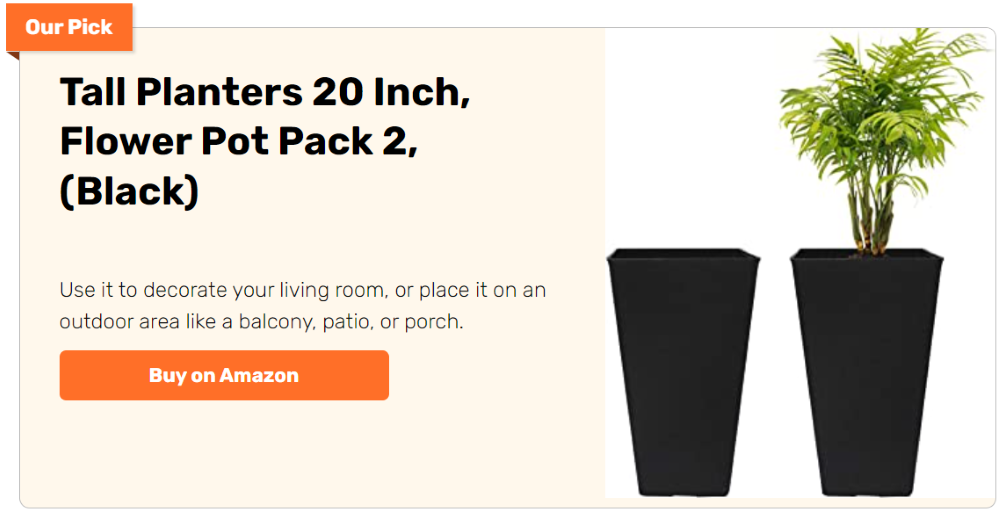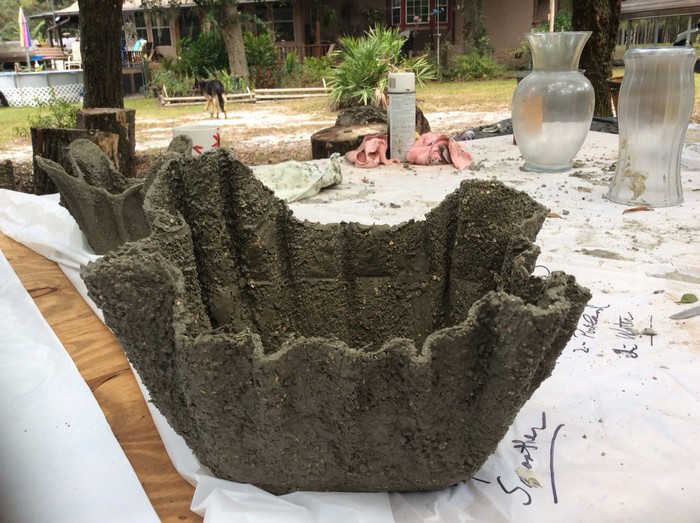Last Updated on March 26, 2024 by teamobn

Here’s an interesting project with an old towel that you don’t like using anymore… a cement/concrete towel planter!
This project is a great way to upcycle those old towels into something new and beautiful. It’s also a great way to add some greenery to your home.
As more people strive to bring a touch of nature into their homes, concrete towel planters are becoming an increasingly popular trend. You’re bringing a unique kind of gardening plan with these concrete containers for your plant that will spark conversations.

Below is you’re complete guide to making your own concrete planter along with other useful information.
Contents
Crafting a Towel Planter
Materials
- 1/2 bag of Quikrete
- Water
- 2 5-gallon Buckets
- 1 Towel
- Gloves (for concrete work)
- Stand / Stool
Tools
- 1 Mixing Stick (for concrete)
- Drill
Instructions
Step 1: Prepare the Workspace
Work in a well-ventilated area or outdoors since you’re working with concrete dust. Lay down plastic sheeting to protect your workspace. Wearing your concrete work gloves is crucial from this point to protect your skin.
Step 2: Mix the Concrete
In one of the 5-gallon buckets, mix the Quikrete with water following the package instructions. Use the mixing stick to stir the concrete mix and water until you achieve a thick, oatmeal-like consistency. Adjust the mix with more water or concrete mix as needed.
Step 3: Soak the Towel
Submerge the towel completely in the concrete mixture. Ensure every part of the towel is thoroughly soaked with the concrete mix. This step is crucial for the strength and durability of your planter.
Step 4: Prepare the Mold
Use the second 5-gallon bucket as your mold. If desired, line the bucket with plastic wrap for easier demolding. Place the stand or stool over the bucket. The stool or stand will support the towel draped in the concrete mix, so it should be positioned centrally over the bucket.
Step 5: Drape the Towel
Carefully lift the soaked towel and drape it over the stand or stool. Adjust the towel to create your desired shape. The middle part of the towel should sag into or just above the bucket to form the planter’s cavity. Smooth out any large wrinkles or folds that may weaken the structure.
Step 6: Let It Cure
Allow the draped towel to cure and harden. You’re towel planter will dry within two days or much quicker if it is a hot a low humid day. Avoid moving the planter during this time to prevent deformation.
Step 7: Remove the Planter
Once the towel planter has fully cured and is hard to the touch, gently lift it off the stand or stool. If you’ve used plastic wrap, it should peel off easily. Turn the planter right-side up. The inside of the bucket mold will now be the top of your planter.
Step 8: Drill Drainage Holes
Using a drill, carefully make drainage holes in the bottom of your planter to allow excess water to escape. This step is essential to prevent overwatering your plants.
Step 9: Finishing Touches
(Optional) Sand any rough edges with sandpaper and paint or seal your planter as desired to match your décor.
Step 10: Add Plants
Fill the planter with suitable potting soil and transplant your chosen plants into the new concrete tower planter.
Troubleshooting Common Issues with Towel Planters
Concrete towel planters are an innovative way to repurpose old towels and bring a touch of nature into your space. While the process is straightforward, certain challenges can arise. Identifying and resolving these issues promptly can make the difference between a stunning planter and a crafting mishap.
Cracking
- Issue: Cracking can occur if the concrete mix is too dry, applied too thinly, or the planter dries too quickly.
- Solution: Ensure your concrete mix is the consistency of thick oatmeal and that the towel is completely saturated. If the weather is hot and dry, cover the planter with plastic during the curing process to slow down the drying time and prevent cracking.
Weak or Crumbly Planter
- Issue: A planter that’s weak or crumbles easily likely didn’t have enough concrete mix soaked into the towel, or the mix was too watery.
- Solution: Make sure the towel is thoroughly soaked with a correctly proportioned concrete mix. It should be fully absorbed but not dripping excessively. Add more concrete mix to areas that seem too thin.
Uneven Shaping
- Issue: The towel may sag or not hold its desired shape if not properly supported during the drying process.
- Solution: Use a stand or stool that matches the shape you aim for with your towel planter. You can also adjust the shape manually in the first few hours of drying, as the concrete begins to set but is still malleable.
Difficulty Removing the Planter from the Mold
- Issue: If the planter sticks to the mold, it can be difficult to remove without causing damage.
- Solution: Line your mold with plastic wrap before draping the concrete-soaked towel over it. This step not only makes demolding easier but also helps in achieving a smoother finish.
Mold Growth or Discoloration
- Issue: Concrete is porous, which can lead to mold growth or discoloration if the planter doesn’t have proper drainage or is in a consistently damp environment.
- Solution: Drill adequate drainage holes at the bottom of your towel planter. Consider sealing the concrete with a suitable sealant to prevent water absorption and protect against mold and discoloration.
Patchy Finish
- Issue: A patchy finish can occur if the concrete mix wasn’t uniform or the towel wasn’t evenly coated.
- Solution: Before soaking the towel, ensure your concrete mix is thoroughly mixed with no lumps. Dip and turn the towel in the mix to achieve an even coating. Apply an additional layer of concrete mix to any areas that appear patchy before the planter begins to set.
Crafting a concrete towel planter is a delightful project that combines creativity with a bit of elbow grease. Encountering issues along the way is part of the learning process. With these troubleshooting tips, you’re well-equipped to overcome common challenges and create a durable, beautiful planter that showcases your plants in style.
Click on any image to start the lightbox display. Use your Esc key to close the lightbox.![]()












Customization and Design Tips for Concrete Planters
Concrete towel planters are a versatile addition to any space, blending seamlessly with a variety of decor styles. From minimalist chic to bohemian vibes, these planters can be customized to suit any aesthetic. Whether you’re a seasoned DIY enthusiast or a crafting novice, these design tips will inspire you to create a planter that’s not only functional but also a reflection of your taste.
Texture and Pattern
The choice of towel is crucial in determining the final look of your planter. A towel with a distinctive texture or pattern can imprint its design onto the concrete, creating interesting visual effects. Consider using towels with a high-relief design for a more dramatic texture.
Color and Dye Techniques
While the color of the towel won’t affect the planter’s final shade, experimenting with colored concrete mixes can add a unique flair. Incorporate concrete dyes to match your planter with your decor scheme or to create vibrant, eye-catching pieces
Embedding Objects
Before the concrete fully sets, consider embedding decorative elements such as pebbles, tiles, sea glass, or even small metal pieces into the surface of your towel planter. These can add color, texture, and personal significance to your creation.
Stenciling and Painting
Once your concrete towel planter is dry and cured, you can further personalize it with paint. Use stencils to apply patterns or motifs. Special concrete paints or outdoor acrylics will ensure your design withstands the elements.Experimenting with Shapes
Molding Techniques
The shape of your concrete towel planter is limited only by the molds you choose. Experiment with different objects as molds to achieve various shapes and sizes. From rounded bowls to square containers, the form of your planter can significantly impact its overall aesthetic.
Creative Draping
The way you drape the towel over your mold can also affect the planter’s shape. Play with asymmetrical designs or folds to create a planter with a modern twist. Adjusting the towel’s position while the concrete is still wet allows for last-minute design changes.

Sealing and Protecting
Applying a sealant not only protects your planter from the elements but can also enhance its appearance. A glossy sealant will give the planter a sleek, modern look, while a matte finish can underscore its rustic charm.
Incorporating Into Your Decor
Think about where your towel planter will reside. For indoor use, consider adding felt pads to the bottom to protect surfaces. For outdoor spaces, pairing your planter with the right plants can complement both the planter’s design and your garden’s aesthetic.
Concrete towel planters offer a unique canvas for personal expression through DIY crafting. With a bit of creativity and these customization tips, you can create a planter that not only serves as a home for your plants but also as a testament to your style and creativity.
Conclusion
Creating a concrete towel planter is a rewarding blend of art and gardening, transforming everyday materials into a functional and decorative piece. This project not only offers a creative outlet but also encourages sustainability through the repurposing of old towels and materials. With endless possibilities for customization, each planter becomes a unique reflection of the maker’s style and the perfect home for nurturing plants.
For more amazing planter ideas, check out our fairy house planter project!








